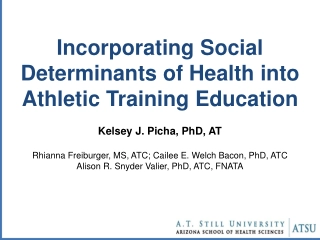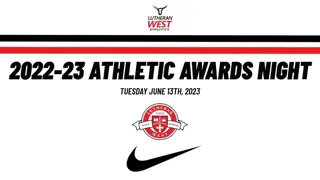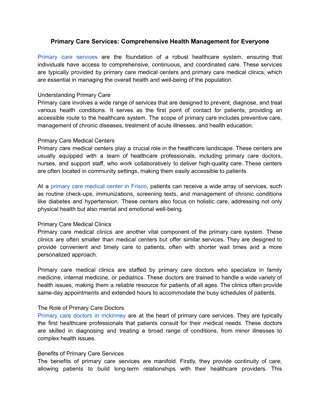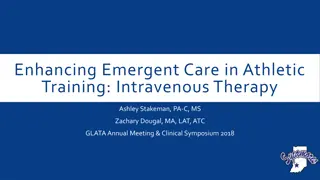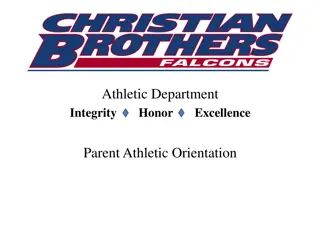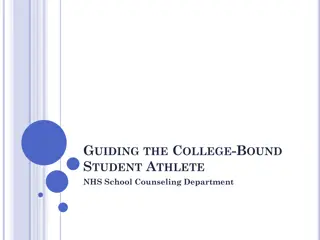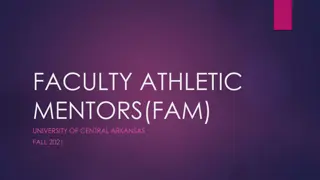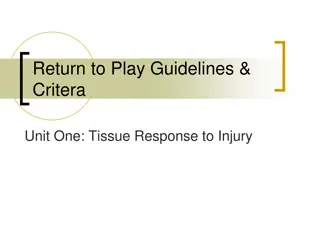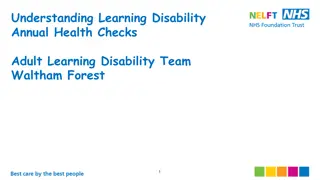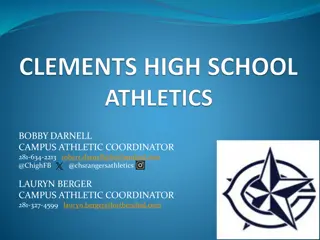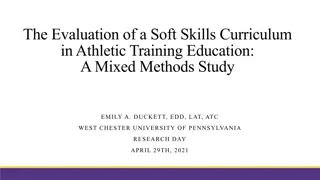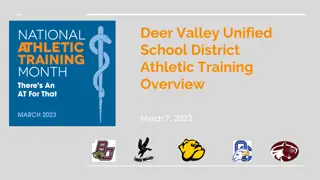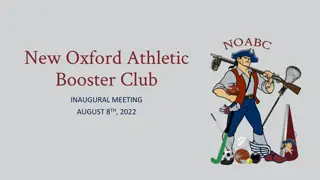Athletic Trainers: Essential Health Care Professionals
Athletic Trainers (ATs) collaborate with physicians to provide preventative services, emergency care, clinical diagnosis, therapeutic intervention, and rehabilitation of injuries and medical conditions. The field of athletic training has evolved over time to prioritize the health and safety of athletes through injury prevention, immediate care, treatment, and rehabilitation. ATs play a crucial role in ensuring the well-being and optimal performance of athletes across various sporting events.
Download Presentation

Please find below an Image/Link to download the presentation.
The content on the website is provided AS IS for your information and personal use only. It may not be sold, licensed, or shared on other websites without obtaining consent from the author.If you encounter any issues during the download, it is possible that the publisher has removed the file from their server.
You are allowed to download the files provided on this website for personal or commercial use, subject to the condition that they are used lawfully. All files are the property of their respective owners.
The content on the website is provided AS IS for your information and personal use only. It may not be sold, licensed, or shared on other websites without obtaining consent from the author.
E N D
Presentation Transcript
Definition:Branch of medicine concerned with the medical aspects of sports participation Athletic Trainers: (ATs) are health care professionals who collaborate with physicians to provide preventative services, emergency care, clinical diagnosis, therapeutic intervention and rehabilitation of injuries and medical conditions.
Evidence of sporting events have been around since early societies Greeks and Romans Athletic training as we know it came into existence during the late 19thcentury with the establishment of intercollegiate and interscholastic athletes in the US. Early athletic trainers possessed no technical knowledge and used various methods such at rubs, ointments, counterirritants and home remedies to treat the athlete It has taken MANY years for the athletic trainer to attain the status of a well-qualified and educated allied health care professional
Historically, training implies the act of coaching or teaching In comparison, athletic training has been known as the field concerned with the athlete s health and safety What is a trainer ???? Someone who trains dogs or horses or functions in coaching or teaching acts What is an ATHLETIC TRAINER??? A certified or licensed individual who specializes in the prevention and care of athletic injuries or illnesses
The AT is the person who deals with the patient throughout the initial injury managementand rehabilitation process from restricted use to return to play activity FIVE DOMAINS 1. Injury/prevention and wellness protection 2. Clinical evaluation and diagnosis 3. Immediate and emergency care 4. Treatment and rehabilitation 5. Organization and professional health and well-being
Prevention Conducting Pre-participation physical exams Developing Training and conditioning programs Ensuring a safe playing environment by minimizing safety hazards Selecting, fitting, and maintaining protective equipment Explaining the importance of diet and lifestyle choices
Proper medication usage Clinical evaluation and diagnosis Understanding pathology of injury and illness Referring patients to medical care Referring patients to other support services Immediate and Emergency Care Treatment and Reconditioning Designing and supervising rehab programs Incorporating Therapeutic modalities
Offering psychosocial intervention Record keeping Ordering equipment and supplies Supervising personnel Establishing policies and procedures Continuing education Educator Counseling and advising patients Research
Stamina and ability to adapt to job Empathy Sense of humor Ability to communicate Intellectual curiosity Ethical Professional membership
Sports Participation In the United States, 6.7 million public high school children are involved in sports activities annually. Title IX Education Assistance Act of 1972 Since its passing, female sports participation increased by 700%. Research indicates injuries are sports specific, NOT gender specific.
*According to a Pennsylvania study, rates of athletic injuries among of high school students were: Football 46.7% Boys basketball 10% Wrestling 9.68% Girls basketball 7.5% In a two-year study of a community sports program, children participating in soccer had the highest rate of injury, followed by baseball, football, and softball. Contusions were the most common injury. Definition of Sports Injury There is no universally acceptable definition. The majority of today s definitions use time lost criteria as the major determinant.
25.5 injuries for every 100 players with the highest rate of injury occurring during games. Game injury rates were double the rates seen in practice. Hip, thigh, and leg regions injured most often. 2.4% of injuries required surgery, and of those 59.4% involved the knee. Contusions, strains, sprains, and fractures are common injuries. Offensive players have higher risk than defensive players. Older players have higher risk than younger ones. Spinal cord and brain injuries are a major concern.
Ankle sprains are the most common injury in both sexes. Girls have higher risk of knee injuries than boys and are more likely to require surgery. The rate of ACL injury during games was 3 times higher for women than men.
over 450,000 high school boys participated. Nearly 12% sustained injuries. Forearm/wrist/hand or shoulder/arm were often injured. Of these injuries, most were strains or sprains. Children between the ages 5 and 14 have increased vulnerability to chest impact injuries from balls. Little League Elbow Chronic elbow injuries are a concern for adolescent pitchers. Sidearm pitching presents the greatest risk for elbow problems.
240,000 high school participants. About 27% sustained injuries. Collisions with opponents and mats, and takedown and escape maneuvers resulted in various injuries. Shoulder/arm, knee, and forearm/wrist/hand were injured most often. Most of these injuries were strains & sprains. Friction burns, skin infections, weight management, and cauliflower ear are also common issues.
Extent of Injuries: Volleyball During 2004, nearly 400,000 high school girls participated. Nearly 15% suffered injury, mostly sprains. Ankle/foot region is most often injured.
In the United States, there are 14 million participants under 18 years of age. During the 2002 season almost: 340,000 high school boys participated. 300,000 high school girls participated. Contusions are the most common injury. The majority of injuries are in the lower extremity accounting for about 60% of total injuries. Female athletes have a higher ratio of knee, specifically ACL, injuries than male athletes. Research has shown that the majority of head injuries result from collisions not intentional heading. Improperly constructed, movable soccer goals have been involved in a number of severe injuries and deaths.
NATA National Athletic Trainers Association 10 Districts; established in 1950 SWATA Southwest Athletic Trainers Association District 6 of the NATA ( Texas and Arkansas); established in 1954
FIMS-International Federation of Sports Medicine AAFP-American Academy of Family Physicians ACSM-American College of Sports Medicine AOSSM-American Orthopedic Society for Sports Medicine NSCA-National Strength and Conditioning Association
American Academy of Pediatrics, Sports Committee APTA-American Physical Therapy Association, Sports Physical Therapy Section NCAA-NCAA Committee on Competitive Safegaurdsand Medical Aspects in Sports NASM-National Academy of Sports Medicine
The teams role in medical management of athletes includes: Coordinating pre-participation physical exams. Providing medical management of injuries and illnesses on and off the field. Coordinating rehab and a safe return to participation after illness or injury. Providing education and counseling for coaches, athletes, and parents. Providing proper documentation and medical record keeping.
Who is Included in the Sports Medicine Team? Primary Care Physicians Orthopedic Surgeons Athletic Trainers Sports Physical Therapists Dentists Exercise Physiologist Strength & Conditioning Coaches Sports Nutritionists Sports Psychologists Podiatrist Biomechanist Sports Massage Therapy Why?
Primary Care Physician (MD)general practitioner Treats acute or chronic illness and provides preventative care and health education for all ages and genders. When your sick, wellness check ups, physicals, etc.. Orthopedic-Doctor who specializes in bones, muscular tissue, joints, ligaments, and tendons. Sets broken bones, dislocations, strains, sprains, degenerative issues, etc
Sports Psychologist Studies the human mind (not a medical Dr.; can not prescribe) Deals with mental health issues among athletes. Career ending injuries, long term rehabilitation, personal issues, etc. Dentist Treats and examines dental issues Broken/Chipped tooth, Avulsion, Infection, etc.. Podiatrist Treats and diagnoses disorders and injuries to the foot and ankle Plantar fasciitis, bunions, foot mechanics, etc
OphthalmologistTreats diseases and conducts surgeries of the eye and pathways Object impaled in the eye, retina detachment, etc Optometrist Conducts eye exams and vision issues related to the eye Glasses and contacts
Exercise Physiologist Study of acute/chronic changes in response to a wide range of exercise conditions (effect of exercise on pathology) Research studies/ clinical trials Biomechanist analyze human motion; studies human movement
Sports Physical Therapist A physical therapist who is highly trained in the rehabilitation, evaluation, and treatment of an injury specifically dealing with an athlete or athletic injury.
Coaches Team Physicians Captain of the Team NATABOC-Certified Athletic Trainer (ATC) or Licensed Athletic Trainer (LAT)
Coachesin public school settings should be trained in: Basic conditioning procedures. Maintenance and fitting of protective equipment. First aid/CPR/AED training Recognition and management of common sports injuries. Skills instruction
LAT Licensed Athletic Trainer: Licensed to practice injury prevention, recognition, assessment, management, treatment, disposing of, and reconditioning athletic injuries under the direction of a physician licensed in the state of Texas. Student must complete 1,800 internship hours to be eligible
BOC- (Board of Certification); CertifiedAthletic Trainer (ATC): an allied health care professional with extensive education in clinical care & prevention of sports injuries. (50 CEU s every two years) The knowledge and skills identified in the Competencies consist of 8 Content Areas: Evidence-Based Practice Prevention and Health Promotion Clinical Examination and Diagnosis Acute Care of Injury and Illness Therapeutic Interventions Psychosocial Strategies and Referral Healthcare Administration Professional Development and Responsibility
To qualify for national certification: Complete a CAATE-accredited Athletic Training Education Program (ATEP). EX: TCU, Texas State, SFA, Baylor, UTA, Texas Tech, Arkansas, UCA, Hardin Simmons, MSU Take certification examination that is now offered via a national network of computerized testing centers Takes 2-4 hours to complete; 150 questions To become an athletic trainer, candidates must graduate with a degree in Athletic Training from an accredited athletic training program and successfully pass the Board of Certification (BOC) Exam. To practice as an athletic trainer in most states, the individual must also be credentialed within the state. Degrees in physical therapy, exercise science, strength and conditioning or others DO NOT qualify the candidate to sit for the BOC examination
Commission on Accreditation of Athletic Training Education CAATE accredits educational programs in athletic training at three different levels: Professional Programs lead to eligibility to sit for the Board of Certification examination and to enter the profession of athletic training. Professional Programs are available at both the baccalaureate and post-baccalaureate degree levels. Post-Professional Degree Programs lead to a degree (masters or doctorate) for learners that are already credentialed as athletic trainers and expand the depth and breadth of the applied, experiential, and propositional knowledge and skills of athletic trainers through didactic, clinical, and research experiences. These programs DO NOT qualify the learner to sit for the BOC exam. Post-Professional Residency Programs are formal educational programs that offer structured curricula, including didactic and clinical components, to educate Athletic Trainers. They are designed to build upon and expand the Athletic Trainer s knowledge and experience acquired during professional (entry-level) education. The database may be searched by program type (professional, post professional degree, post professional residency), degree level, or state.
Colleges/Universities Secondary Schools Professional Sports Rehabilitation Clinics/Hospitals Industrial Settings NASCAR Academic Corporate Settings Military Rodeo Fine Arts Law Enforcement NASA Medical Equipment Sales Physician Extender Recreational Sports
Open Position Postings School websites, professional association websites (TSATA, NATA & SWATA) Networking Annual Symposiums/conferences Job postings and interviews
Name/Contact Information Objective Education Certifications/Licenses Work Experience Awards/honors Activities References


